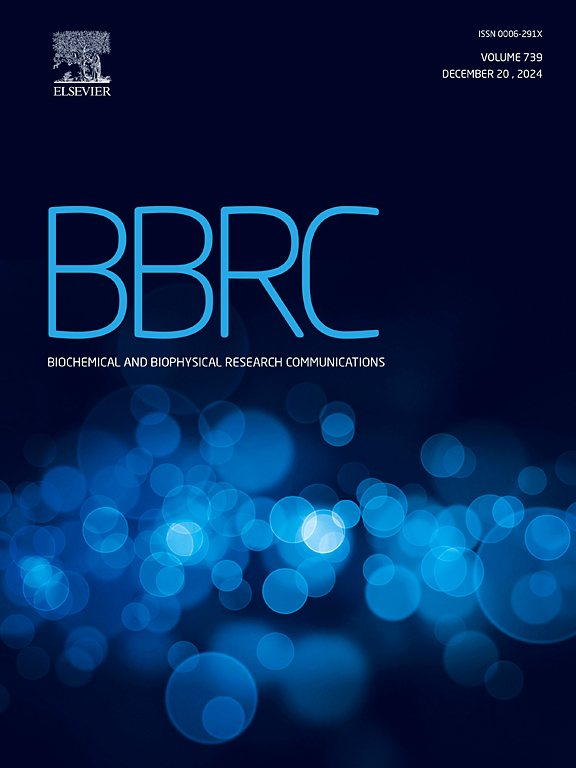1,25(OH)2D3 promotes insulin secretion through the classical pyroptosis pathway in vitro and vivo
IF 2.5
3区 生物学
Q3 BIOCHEMISTRY & MOLECULAR BIOLOGY
Biochemical and biophysical research communications
Pub Date : 2025-01-01
DOI:10.1016/j.bbrc.2024.151058
引用次数: 0
Abstract
Background
Diabetes is a chronic metabolic disorder characterized by persistently elevated levels of blood glucose. Research has demonstrated a close relationship between inflammation and the development of diabetes. Vitamin D has been shown to be significantly associated with type 2 diabetes; however, the mechanisms by which it regulates inflammation during the onset of the disease remain incompletely understood. In this study, we investigated the effect of pyroptosis on pancreatic β-cell function in diabetes and explored the role of 1,25(OH)2D3 in type 2 diabetes through the pyroptosis signaling pathway.
Methods
In both in vivo and in vitro settings, we established a diabetes model combined with 1,25(OH)₂D₃ intervention to investigate its impact on insulin secretion levels, the release of inflammatory factors, and the expression levels of pyroptosis-related proteins.
Results
In both in vivo and in vitro experiments, we have observed that 1,25(OH)₂D₃ exhibits anti-inflammatory properties by downregulating the expression levels of pyroptosis-related proteins. Furthermore, it provides protection against pancreatic β-cell damage caused by type 2 diabetes mellitus (T2DM) and enhances insulin secretion. Inhibition of gasdermin D (GSDMD) expression impedes the progression of cell pyroptosis, reduces the amplification of the inflammatory response, and protects pancreatic cells from injury.
Conclusion
We hypothesize that the induction of pancreatic cells through pyroptosis occurs via the classical pathway in T2DM, and propose that 1,25(OH)2D3 may have a beneficial effect on this process. Consequently, 1,25(OH)2D3 could potentially serve as an adjuvant to inhibit the pyroptosis of pancreatic β cells by targeting the classical signaling pathway, thereby reducing the inflammatory response and alleviating symptoms associated with diabetes.
1,25(OH)2D3在体外和体内通过经典的焦亡途径促进胰岛素分泌。
背景:糖尿病是一种以血糖持续升高为特征的慢性代谢性疾病。研究表明,炎症与糖尿病的发展有着密切的关系。维生素D已被证明与2型糖尿病显著相关;然而,它在疾病发病期间调节炎症的机制仍然不完全清楚。在本研究中,我们研究了焦亡对糖尿病胰腺β细胞功能的影响,并通过焦亡信号通路探讨了1,25(OH)2D3在2型糖尿病中的作用。方法:在体内和体外建立糖尿病模型,结合1,25(OH)₂D₃干预,研究其对胰岛素分泌水平、炎症因子释放和焦解热相关蛋白表达水平的影响。结果:在体内和体外实验中,我们观察到1,25(OH)₂D₃通过下调热降解相关蛋白的表达水平而表现出抗炎特性。此外,它对2型糖尿病(T2DM)引起的胰腺β细胞损伤提供保护,并促进胰岛素分泌。抑制气皮蛋白D (GSDMD)的表达可以阻止细胞焦亡的进展,减少炎症反应的放大,并保护胰腺细胞免受损伤。结论:我们假设T2DM患者通过经典途径诱导胰腺细胞焦亡,并提出1,25(OH)2D3可能在这一过程中起有益作用。因此,1,25(OH)2D3可能作为一种佐剂,通过靶向经典信号通路抑制胰腺β细胞的焦亡,从而减少炎症反应并缓解糖尿病相关症状。
本文章由计算机程序翻译,如有差异,请以英文原文为准。
求助全文
约1分钟内获得全文
求助全文
来源期刊
CiteScore
6.10
自引率
0.00%
发文量
1400
审稿时长
14 days
期刊介绍:
Biochemical and Biophysical Research Communications is the premier international journal devoted to the very rapid dissemination of timely and significant experimental results in diverse fields of biological research. The development of the "Breakthroughs and Views" section brings the minireview format to the journal, and issues often contain collections of special interest manuscripts. BBRC is published weekly (52 issues/year).Research Areas now include: Biochemistry; biophysics; cell biology; developmental biology; immunology
; molecular biology; neurobiology; plant biology and proteomics

 求助内容:
求助内容: 应助结果提醒方式:
应助结果提醒方式:


